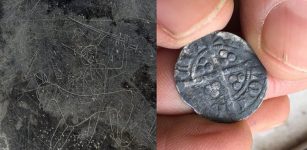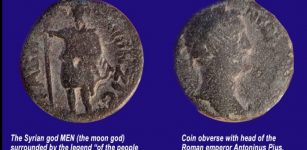Daily Life Of Priests And Priestesses In Ancient Egypt
Angela Sutherland - AncientPages.com - In ancient Egypt, where religion was an important part of daily life, everything focused on pleasing the gods.
Certain gods such as Bes and Tawaret who protected ordinary people in their daily life were worshiped privately in their homes.
Priests Performing Funeral Rites. Image source
Egyptian priests devoted their lives to the gods and goddesses and some official gods like Horus, Bastet and Amun were worshiped by the pharaoh and priests in large temples.
When a god decided to take a temporary, earthly dwelling within a statue, the priests should wash the statue, dress it, and serve it the best delicious food.
Every temple had several small (about 22 inches tall) statues of different gods that were the focus of the worshiper’s daily and seasonal rituals.
Why Was Extreme Hygiene Of A Priest Crucial?
It was believed that the human world was rather dirty, so priests and priestesses had to take care of the temple and the statue of the god within it.
Each statue was cleaned every day with lotus-scented water, anointed with oil, dressed and decorated with jewelry and make-up. Also, priests themselves would be extremely clean throughout the body.
The Greek historian, Herodotus (ca 480-420 BC) who visited many Egyptian temples during his traveling, wrote: "they bathe in cold water twice a day and twice a night…"
Rich temples had their own holy lakes where the priests had to bathe. If a temple was not rich enough to have its own lake, the priests had to settle for a sink. But Herodotus wrote that it was not enough with a bath:
"The priests circumcise for purity because they prefer purity in front of comfort. They shave everywhere on their bodies, at least every other day to avoid lice and anything else that's as unpleasant… "’
Interestingly, some temples had very strict rules and required that the priests also shaved eyebrows and eyelashes.
Priests of both sexes usually spent several hours practicing the songs and dances to please the gods.
Most Egyptian Priests Lived Ordinary Lives Outside The Temple Walls
About 1319 BC when Pharaoh Horemheb ruled the country, the number of priests in Egypt had reached more than 100,000, but many of them were free citizens and only worked in the temple for a longer or shorter time.
Painting of Prince Khaemwaset (Setne Khamwas) from the 20th Dynasty in his tomb (QV44). Image source
When the priest or priestess did not dance, sing or sacrifice to the glory of the deity, he or she was busy with inspection of local farms and fields, owned by the temple, or had responsibilities regarding craftsmen and hunters.
A priest, who was not on duty, was allowed to live a normal life, and marriage was permitted.
When it was time to serve God again in the temple, the skin would be completely smooth and clean; the priest would abstain from sex for at least one day before the holy duties were resumed.
Embalming, Spell Formula And Sick Visits
The Egyptian funeral ritual took place outside the temple walls. The priest had to supervise the embalming act, visit sick people, and pronounce spells that would bring the deceased safely to the other side.
Food Ceremony In The Temple
Food was served for the god three times a day and breakfast preparations started always a few hours before dawn. The gods were served fresh meat every day, and different fruits were served on barrels richly decorated with fresh flowers. The temple’s own bakery delivered fresh bread, pastry makers prepared sweet cookies, and beer and wine were served.
After the meal was finished, the priests and all employees could begin to eat.
Not all priests ate much and many of them especially those deeply devoted to the priesthood, satisfied themselves with bread and water, only.
Written by – A. Sutherland - AncientPages.com Senior Staff Writer
Copyright © AncientPages.com All rights reserved. This material may not be published, broadcast, rewritten or redistributed in whole or part without the express written permission of AncientPages.com
More From Ancient Pages
-
 Yokai Amabie – Protective Ancient Spirit That Can Ward Off Epidemics
Featured Stories | Mar 30, 2020
Yokai Amabie – Protective Ancient Spirit That Can Ward Off Epidemics
Featured Stories | Mar 30, 2020 -
 Ancient City Of Tyana And A 1600-Year-Old Rare Octagonal Church Unearthed In Central Anatolia Turkey
Archaeology | Aug 11, 2020
Ancient City Of Tyana And A 1600-Year-Old Rare Octagonal Church Unearthed In Central Anatolia Turkey
Archaeology | Aug 11, 2020 -
 The Faery Grail Of Hospitality And Accord – Secrets Of The Elucidation – Part 2
Featured Stories | Sep 27, 2019
The Faery Grail Of Hospitality And Accord – Secrets Of The Elucidation – Part 2
Featured Stories | Sep 27, 2019 -
 Rare Viking Graffiti And Artifacts Found In Dublin – Depiction Of God Odin Riding Sleipnir Followed By Huginn And Muninn?
Archaeology | Mar 31, 2018
Rare Viking Graffiti And Artifacts Found In Dublin – Depiction Of God Odin Riding Sleipnir Followed By Huginn And Muninn?
Archaeology | Mar 31, 2018 -
 Is The World’s Oldest Zero Hidden In The Bakhshali Manuscript?
Archaeology | Oct 28, 2017
Is The World’s Oldest Zero Hidden In The Bakhshali Manuscript?
Archaeology | Oct 28, 2017 -
 Ancient Necropolis With Lead Coffins Sheds Light On Early Christian Funeral Practices
Archaeology | Jul 13, 2020
Ancient Necropolis With Lead Coffins Sheds Light On Early Christian Funeral Practices
Archaeology | Jul 13, 2020 -
 Barabar Caves: The Oldest Surviving Rock-Cut Caves With Acoustic Effects In India
Featured Stories | Jul 1, 2021
Barabar Caves: The Oldest Surviving Rock-Cut Caves With Acoustic Effects In India
Featured Stories | Jul 1, 2021 -
 Unique 1800-Year-Old Roman Coin Unearthed On Southern Carmel
Artifacts | Mar 1, 2021
Unique 1800-Year-Old Roman Coin Unearthed On Southern Carmel
Artifacts | Mar 1, 2021 -
 Ancient Secrets Of Iberian Warrior Vase – 2,000-Year-Old Masterpiece Of Art
Archaeology | Dec 5, 2017
Ancient Secrets Of Iberian Warrior Vase – 2,000-Year-Old Masterpiece Of Art
Archaeology | Dec 5, 2017 -
 Ancient DNA Sheds New Light On The Fall Of Major Civilizations
Archaeology | Aug 9, 2022
Ancient DNA Sheds New Light On The Fall Of Major Civilizations
Archaeology | Aug 9, 2022 -
 Lost Ancient Pyramid City As Big As Manhattan Discovered In Mexico
Archaeology | Feb 17, 2018
Lost Ancient Pyramid City As Big As Manhattan Discovered In Mexico
Archaeology | Feb 17, 2018 -
 The Oldest Denisovan Fossils Ever Discovered Shed New Light On Early Hominins As They Spread Across Eurasia
Archaeology | Nov 30, 2021
The Oldest Denisovan Fossils Ever Discovered Shed New Light On Early Hominins As They Spread Across Eurasia
Archaeology | Nov 30, 2021 -
 Did Leonardo Da Vinci Invent Contact Lenses In 1508?
Ancient Technology | Dec 10, 2015
Did Leonardo Da Vinci Invent Contact Lenses In 1508?
Ancient Technology | Dec 10, 2015 -
 Ancient Greek Goddesses Aphrodite And Artemis – Rivalry And Conflict Over Prestige Illustrated In Hippolytus By Euripides
Featured Stories | Jun 13, 2018
Ancient Greek Goddesses Aphrodite And Artemis – Rivalry And Conflict Over Prestige Illustrated In Hippolytus By Euripides
Featured Stories | Jun 13, 2018 -
 Rare Gilded Mask Discovered On Mummy Of Ancient Egyptian Priest Serving Sky Goddess Mut
Archaeology | Jul 17, 2018
Rare Gilded Mask Discovered On Mummy Of Ancient Egyptian Priest Serving Sky Goddess Mut
Archaeology | Jul 17, 2018 -
 Stonehenge’s Monumental Altar Stone Came From Scotland – Not Wales As Previously Thought
Archaeology | Aug 16, 2024
Stonehenge’s Monumental Altar Stone Came From Scotland – Not Wales As Previously Thought
Archaeology | Aug 16, 2024 -
 Fossil Of Prehistoric Saber-Toothed Cat Found In Texas
Fossils | Jun 11, 2024
Fossil Of Prehistoric Saber-Toothed Cat Found In Texas
Fossils | Jun 11, 2024 -
 Bighorn Medicine Wheel: Sacred Site And Ancient Solar Observatory
Civilizations | May 29, 2016
Bighorn Medicine Wheel: Sacred Site And Ancient Solar Observatory
Civilizations | May 29, 2016 -
 Triumphal Arch Of Roman Emperor Constantine And His Great Vision
Featured Stories | Jul 12, 2017
Triumphal Arch Of Roman Emperor Constantine And His Great Vision
Featured Stories | Jul 12, 2017 -
 Ancient Human Traces Found In The Inhospitable Namib Desert
Human Beginnings | Oct 21, 2024
Ancient Human Traces Found In The Inhospitable Namib Desert
Human Beginnings | Oct 21, 2024


